Although you could currently have a restaurant or be building one, moving online might enable you to grow more successfully. Starting a food delivery company from nothing also seems like work, but all you really need is a great concept, the correct app development team, and the will to bring it to fruition. Although you may be driven to guarantee the proper implementation of the strategy, all you need is some direction and instructions, because the better your concept is for your food delivery company,.
You have to look after many aspects, including your company plan, technical tools, income source, delivery app development, hiring food delivery app developers, and more. Therefore, this article will guide you on how to create a food delivery app for startups.
Market Trends for Food Delivery Apps
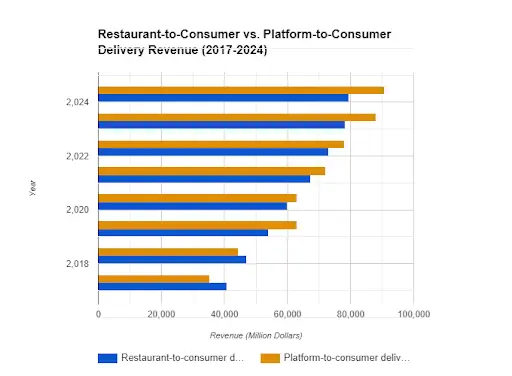
The data is divided into two categories:
-
-
The number of platform-to-consumer delivery customers is estimated to reach 2,114.3 million by 2025. Revenue is estimated to rise at a 9.37% annual rate (CAGR 2021–2025), with a projected market volume of $247,428 million by 2025.
-
By 2025, the restaurant-to-consumer delivery category is estimated to have 1,845.2 million customers. Furthermore, the revenue is estimated to expand at a 10.82% annual rate (CAGR 2021-2025), resulting in a projected market volume of US$201,864 million in 2025.
-
So, if you're looking to design a food delivery app, you've come to the correct spot. Let's go over the several main aspects of food delivery mobile apps, from features to the current market of food delivery app developments. But first, let's look at how the pandemic affected the business and how the current food delivery software method evolved in reaction to it.
Food Delivery Industry in 2024
Despite significant expansion in the food delivery market, several businesses struggled to prosper at the start of 2020. Many significant firms, including Postmates, DoorDash, and Uber Eats, were in talks about combining in different combinations, but none of the verbal discussions resulted in a solid conclusion. Subsequently, a global catastrophe unfolded: a pandemic emerged, causing widespread disruption.
So, during the lockdown, food delivery services increased dramatically. Everyone wanted to receive vital supplies and consumables delivered to their homes. As a result, the quarantine period provided an opportunity for on-demand food delivery apps to thrive.
Although industrial titans may dominate the market, this is not entirely true. During the pandemic, on-demand food delivery companies emerged throughout the globe and continued to grow in popularity.
Glovo, a Spanish firm that collaborates with brick-and-mortar companies to deliver restaurant takeout, groceries, and other products, has raised $528 million in investment. Similarly, Gousto, a UK food-kit delivery startup, garnered $41 million during the shutdown.
Gorillas, an on-demand grocery delivery business that aspires to deliver products in 10 minutes or fewer, has received $290 million, more than its original $1 billion value.
Business Models of Food Delivery Apps For Startups in 2024
When creating a feature-rich food delivery app solution, it's essential to understand three key business models. Let's explore these categories and their benefits.
Order And Delivery Model
In this food delivery company model, the owners contract a delivery service provider to ensure timely and effective deliveries. The third-party delivery company is responsible for determining the delivery costs for food orders.
This business model is ideal for a food company owner who does not want to invest in a delivery fleet but wants the food to be delivered to their customers' homes. You can control delivery by collaborating with logistics services such as Uber Eats. However, it is critical to monitor and follow the delivery partner to guarantee that your services live up to the promises given to clients. You can also build an app like Uber Eat with the help of a food delivery app development company like JpLoft.
Aggregator Business Model
This online food delivery business concept offers a platform that connects businesses and consumers. It does this by integrating numerous food establishments into its platform. Customers may thus browse many eateries in one location. As a food delivery company, you may begin with a subscription model, allowing consumers and restaurants to subscribe to your platform. This will be a safer alternative for ensuring your business's returns.
Full-Service Business Model
As the name implies, you handle everything from cooking to delivering the food. Everything will be done in-house, which will demand a significant investment. However, since you will have complete control over the whole process under this approach, you will most likely make far more. Domino's and McDonald's are two examples of successful businesses that follow this approach. For building a full-service food delivery app, you need to create a team of app developers and hire food delivery app developers, or you can also hire a mobile app development company for your food delivery app.
Is It Worth To Invest In A Food Delivery Business?
The food delivery industry is one of the most rapidly growing industries of our day, therefore, there's little question that it'll be a profitable venture. As per Statista, the platform delivery industry is projected to reach $340.80 billion by 2028, with a compound annual growth rate (CAGR) of 4.79% from 2024 to 2028. The user penetration rate is predicted to reach 19.1% by the same year.
To be more precise, the global online food delivery market is projected to reach $505.50 billion by 2030, with a compound annual growth rate (CAGR) of 10.3% from 2023 to 2030. The growing market share may be linked to the convenience and accessibility that online food delivery platforms provide to customers. Furthermore, increased smartphone use and internet penetration have contributed to the growing size of the food delivery industry.
When you look at the demographics of those who use food delivery apps the most, you'll see that Millennials and Generation Z are the most likely to utilize them. Approximately 80% of US diners are buying online at the same or higher rates as last year. In addition, orders in the United States have increased significantly during off-peak hours, with late-night purchases up 36% and morning orders up 23%.
Keeping all of this in mind, it is reasonable to assume that if you want to start a food delivery company, the future is likely to be promising.
Features of Food Delivery App
As a well-known mobile app development firm, we have curated a list of all the essential features that a food delivery app should have for users, restaurant owners, and drivers. Let's dive into the features of food delivery app development:
Customer’s App Module
Search Filter
The search filter enables visitors to find and explore cafés and restaurants based on their location and cuisine.
Order Placement
Customers may make orders for great cuisine from their favorite restaurants with only a few clicks. Customers may choose their preferred food and add it to their basket. Then they may place the final order.
Real-Time Location
Customers may follow the location of their ordered food using a geolocation map after placing it. Isn't it a terrific feature for developing the greatest and most current food delivery apps? It enables clients to see how long a delivery guy will take to deliver. This helps to build confidence and credibility in food delivery service companies. You must add this key feature to your food delivery app development, as it is one of the most demanded features in delivery app development services. You can partner with a mobile app development company that has highly skilled food delivery app developers.
Payment Gateway Integration
Payment gateway integration enables consumers to pay for their food orders online using debit/credit cards, internet banking, and other methods. Restaurants, on the other hand, may easily accept payments using payment gateway integrations such as PayPal, Stripe, and so on.
Reviews and Ratings
Feedback and consumer evaluations are vital to creating robust market competitiveness. You should include this function for your users to rate and review your app or services so that you can overcome problems and win over consumers' hearts. The review and rating system is beneficial to customers as well as food delivery business owners in that business owners can easily improve their services, and customers can notify and share their experiences, by which other customers can also make decisions on the purchase and ordering from your food delivery services.
Order History
Order history has proven to be a time-saving service for users. It helps them to maintain and review previous orders. Furthermore, they may repeat past orders whenever necessary.
Nearby Restaurants
It enables visitors to see all of the best and closest restaurants, depending on their location. Users may also browse the menu, prices, and reviews before ordering a food.
Delivery Driver’s App Module
Registration
This enables drivers to log in or sign up for the app using their phone numbers, Gmail, or other social media networks. The whole registration or login process should be simple so that new members can quickly enroll themselves.
User Profile
This user profile allows a driver to submit information such as their name, email address, contact information, picture, and other facts. As a result, consumers may more easily access their fundamental information.
Alerts and Notifications
This notification function, on the other hand, notifies drivers of new orders that have been issued. When drivers are not using the delivery app, they should hear a sound alert for any orders that have been requested. Notification and alert features are needed features in the food delivery app services. To integrate these features, you can hire mobile app developers, or you can also partner with the food delivery app development service providers.
Manage Multiple Deliveries
At the same time, drivers may manage and react to a variety of food delivery orders. They may accept any request that is near another delivery location.
GPS-Map Integration
GPS Map Integration is one of the most helpful and outstanding capabilities for delivery drivers. GPS assists the food delivery worker by recommending the most convenient path. A delivery worker may be compelled to add a last-minute order, in which case he must take a shorter route to get at the location on time.
Call/Chat Option
If the customer has an issue, the delivery person may contact them via chat or phone.
Order History
This feature allows the delivery agent to examine their food delivery order history and payment details.
Admin Dashboard Module
Performance Analysis
An administrator may monitor all activities conducted by users or delivery personnel on the food delivery app solutions. The admin dashboard enables users to keep track of food delivery, drivers, and scheduled/canceled orders, as well as see driver details.
Manage Order Requests
You may handle anything from food package pick-ups to deliveries and scheduled orders. You are accountable for streamlining orders and delivering them to clients on schedule.
Radixweb Can Aid With Real-Time Updates
The availability of delivery agencies and restaurants must be monitored by the government. This tool allows you to get real-time updates and alerts regarding drivers and restaurant owners, such as revisions to their profiles, restaurant hours, and availability.
Payment and Commission Administration
The admin interface allows food delivery agents and restaurants to control payment and commission rates for each food order.
Offers and Discounts
It enables the administrator to provide different discounts and promo codes inside the app.
Push Notifications
Admin receives alerts and updates after the driver accepts the order requests and is on his way to collect/deliver the package.
Restaurant Management
It enables the administrator to add and remove eateries from the app.
Campaign Management
The administrator may launch and manage several campaigns using email, SMS, and social media marketing.
Trends in Food Delivery App Development
Keeping up with current trends might offer your app a competitive advantage. Below are some current trends in food delivery app development:
AI and Machine Learning
AI and machine learning may improve the customer experience by making tailored suggestions, improving delivery routes, and forecasting delivery times. To make a food delivery app that uses AI and machine learning features, you need to partner with a mobile app development service provider, or you can also hire mobile app developers who are experts in AI and machine learning.
Subscription Models
Offering membership options that provide free delivery, unique discounts, and priority assistance may increase customer loyalty and retention.
Integration of Wearables
Integration with wearable devices such as smartwatches allows consumers to get real-time alerts and updates, improving their entire experience.
Eco-Friendly Practices
As sustainability becomes more essential, eco-friendly methods such as utilizing biodegradable packaging and optimizing delivery routes to decrease carbon footprints may appeal to environmentally aware customers.
Contactless Delivery
In response to the pandemic, numerous applications now provide contactless delivery choices. This tendency is expected to continue as consumers prioritize safety.
How to Start a Food Delivery Business as a Startup
After you've decided on a business plan, you may be sure that creating a food delivery app is a viable idea. However, it is always advisable to comprehend the market, competitors, and problems that you may experience along this growth path. Taking a deliberate approach will allow you to effectively reach your goals. Here are the steps you may take to establish a food delivery business:
Research The Market
Begin by doing detailed food delivery market research. You may use this to create your restaurant's menu, combining your love of dining with a source of income. Develop an acceptable entrance strategy by focusing on understanding market dynamics. Here are some crucial variables to consider:
Competitors
Platform-to-consumer and restaurant-to-consumer operators, with their delivery infrastructure, control a significant piece of the food delivery business. Investigate their pricing policies, online menus, and marketing strategies to position your organization attractively in contrast to their rivals' services.
Opportunities and Threats
Conduct a strengths, weaknesses, opportunities, and threats (SWOT) study to compare key characteristics of your business to those of your competitors. Using the analysis, you may capitalize on your strengths, assess your weaknesses, grasp new opportunities, and identify risks.
Target Audience
You must be aware of the clients you want to target. If you currently own a restaurant, your current customers will be your target market. However, if you're launching a firm, choose a market where you can have the most significant effect. The menu ought to mirror your unique culinary style, while also catering to the preferences and expectations of your intended audience.
Determine Your Costs And Budget
According to company founders, a food delivery startup typically costs between $3,000 and $25,000, with monthly overheads ranging from $600 to $10,000. Let's talk about some of the significant expenditures related to beginning and running a food delivery service:
Inventory
For a new restaurant, you will need a location, kitchenware, interior décor, flooring, and so on. However, a cloud or virtual kitchen is an excellent option if you simply want to make a minimal investment. You may considerably cut your inventory expenditures.
Technology Costs
It will cost you between $30K and $150K to start a food delivery firm from scratch. The pricing is decided by the app's complexity, functionality, development team, location, and other features. However, you may save costs by working with a food delivery app developer.
Business Licenses And Insurance
The expense of obtaining a valid business license and insurance raises the initial expenditures of a food delivery service. For example, consider liability insurance and business motor insurance. Additionally, some states require firms to have worker's compensation insurance. Monitor these ever-changing criteria.
Cost of Marketing
The cost of marketing and promotion influences how much it costs to establish a food delivery business. Advertising your company to millions of internet consumers will aid in social media, banner advertising, email marketing, and other forms of advertising. For digital marketing, you can partner with a digital marketing company like JPloft, as we have been in this business for the last 11 years, and we have a highly skilled digital marketing team that helps you to grow your business with the speed of light.
Logistics
Launching a food delivery business can be expensive due to logistics costs. If you plan to have your own fleet for delivery, you'll need to budget for vehicles and driver salaries. If not, you may order food deliveries from third-party delivery services in exchange for a fee of 20% to 30%.
Monetize in Food Delivery App Development
If you want to establish a food delivery service, you must first determine which revenue sources will provide you with sufficient returns to cover your investment and generate profits. This is how income-generating often occurs in delivery food businesses:
Restaurant's Fee
You will charge restaurants and shops to display their ads or menus on your platform. The more they pay, the higher they will rank on the list. In exchange, you will deliver the food to them and highlight them on your application.
Delivery Fee By Customers
The customer pays for the majority of the shipping costs. They pay for the food that is brought to them. The quantity is decided by the place where the order is to be delivered.
Commission On Each Order
Typically, there is a 20-30% fee associated with every food order that goes to the food delivery provider. This implies you will transfer a certain part of each order to your company.
Advertisements
This is a frequent strategy to generate income. Brands and businesses opt to display their advertisements on the app, and in exchange, they pay a fee to the platform.
Also Read : How To Build An App Like KFC UAE in 2024
Wrapping Up
Venturing into on-demand food delivery app development in 2024 offers significant potential for startups ready to tap into this burgeoning market. By leveraging expert food delivery app development services, you can create a custom food delivery application that meets the specific needs of your target audience. Partnering with a reliable food delivery app development company ensures access to cutting-edge technology and industry best practices.
As you embark on this journey, consider collaborating with a top-tier on-demand food delivery app development company to bring your vision to life. This partnership will help you navigate the complexities of app development and integrate essential features like real-time tracking and seamless payment gateways. To maximize your app's success, hire food delivery app developers who can provide the expertise and skills necessary to build a user-friendly and efficient platform.
With the food delivery industry's rapid growth and evolving trends, having a well-developed app will position your startup for success. By prioritizing innovation, enhancing user experience, and strategic development, you can craft a compelling and competitive food delivery application that distinguishes itself in the market.





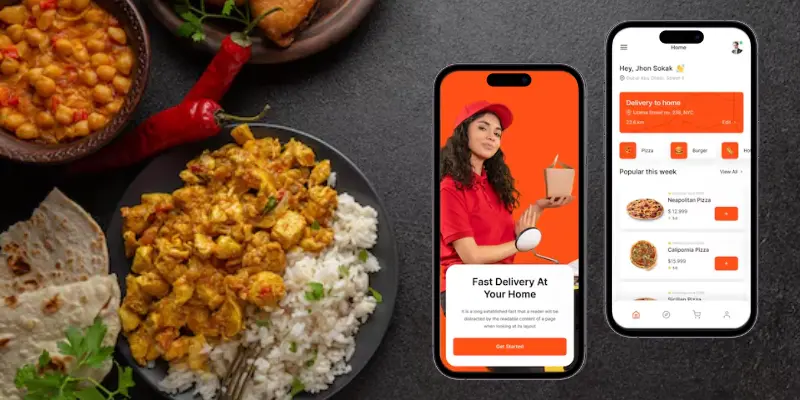

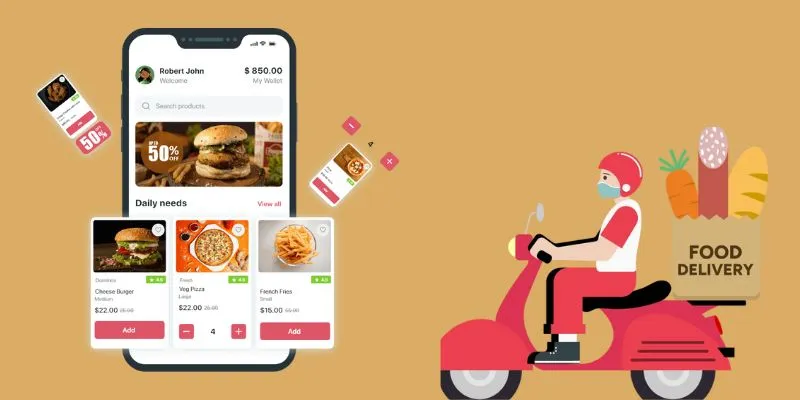
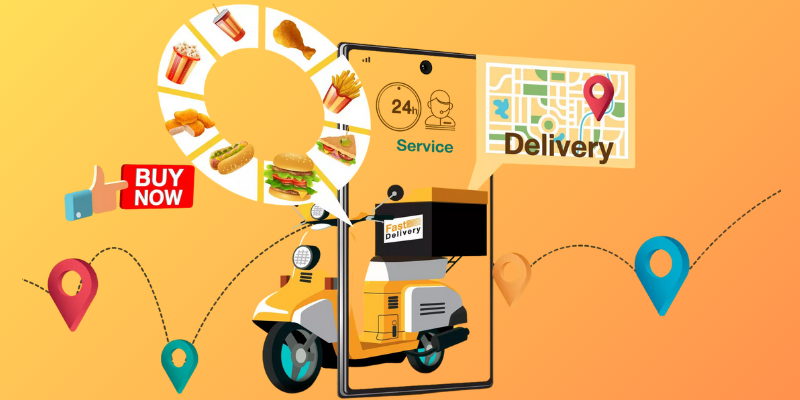
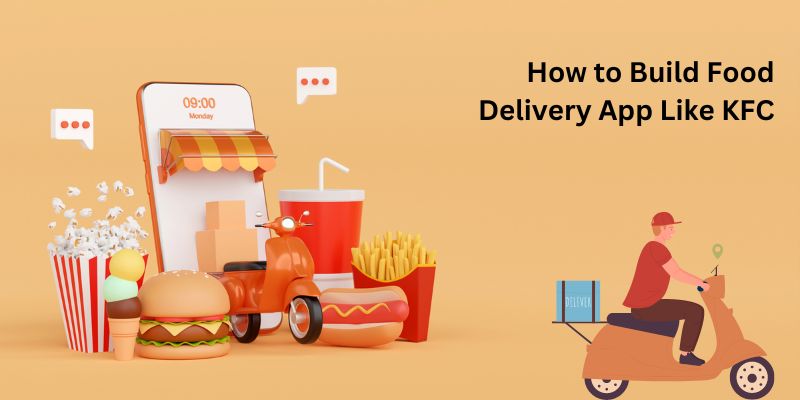



Share this blog